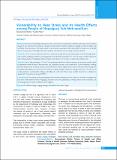Please use this identifier to cite or link to this item:
https://hdl.handle.net/20.500.14356/1516| Title: | Vulnerability to Heat Stress and its Health Effects among People of Nepalgunj Sub-Metropolitan |
| Authors: | Bhatta, Kusumsheela Pahari, Sandip |
| Citation: | BhattaK., & PahariS. (2021). Vulnerability to Heat Stress and its Health Effects among People of Nepalgunj Sub-Metropolitan . Journal of Nepal Health Research Council, 18(4), 763-768. https://doi.org/10.33314/jnhrc.v18i4.2734 |
| Issue Date: | 2020 |
| Publisher: | Nepal Health Research Council |
| Article Type: | Original Article |
| Keywords: | Climate change Coping strategy Heat index Heat stress |
| Series/Report no.: | Oct-Dec, 2020;2734 |
| Abstract: | Abstract Background: Record-breaking temperatures have occurred more frequently worldwide under the trend of climate change. It has increased the number of people at heat related medical conditions resulting in both mortality and morbidity from heat stress. This study aimed to assess factors associated with vulnerability to heat stress, its health effects among people of Nepalgunj Sub-metropolitan, and identify various coping strategies adopted. Methods: Cross-sectional analytical study was conducted among 366 research participants selected through multi-stage random sampling technique in Nepalgunj Sub-metropolitan. Heat Index was assessed using secondary analysis of meteorological data of Nepalgunj (Airport) station. Chi-square test was done to analyze the primary data. Results: Out of 366 participants, 224 (61.2%) participants had heat related symptoms in the past 6 months (April to September) from the date of the interview. Sex, education, income, roof construction, Cross-ventilation, working hour per day, presence of chronic disease, and medications use had a significant association with heat related symptoms among the participants (p<0.05) The most common coping strategies adopted to manage heat stress were the use of cooling methods, wearing light clothing, and bathing by cold water. The average monthly heat index was highest in August (42 °C) and lowest in April (29°C). Conclusions: The majority of the participants had heat related symptoms in the study area. In order to mitigate the heat stress in the urban town like Nepalgunj, measures such as tree plantation, reducing vehicle smoke emissions, and developing proper housing ventilation can be applied. Keywords: Climate change; coping strategy; heat index; heat stress; Nepal |
| Description: | Original Article |
| URI: | http://103.69.126.140:8080/handle/20.500.14356/1516 |
| ISSN: | Print ISSN: 1727-5482; Online ISSN: 1999-6217 |
| Appears in Collections: | Vol. 18 No. 4 (2020): Vol. 18 No. 4 Issue 49 Oct-Dec 2020 |
Files in This Item:
| File | Description | Size | Format | |
|---|---|---|---|---|
| 2734-Manuscript-20015-1-10-20210122.pdf | Fulltext Download | 242.5 kB | Adobe PDF |  View/Open |
Items in DSpace are protected by copyright, with all rights reserved, unless otherwise indicated.
